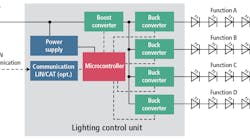This article was published in the November/December 2011 issue of LEDs Magazine.
View the Table of Contents and download the PDF file of the complete November/December 2011 issue.
+++++
Portable equipment that uses LED-based solid-state lighting (SSL) requires an efficient drive circuit that prolongs battery life, as well as dimming options to adjust the light output for the ambient lighting conditions. LED dimming is necessary in applications such as the backlight for smart phones or portable GPS navigation systems to ensure an easily readable display in both bright sunlight and the dark of night. In flashlights, a user may deem longer battery life more important than delivering the most light possible. Either analog dimming or pulse-width-modulation (PWM) dimming can be used in such applications. By using an innovative approach to creating a reference voltage, an analog design can prove more efficient than PWM-based designs.
Both analog and PWM dimming techniques control the LED drive current, which is proportional to the light output. Analog dimming is simple, requires the least control overhead, and generally is more efficient than PWM dimming due to the lower forward voltage of the LEDs at lower drive currents.
Analog dimming, however, requires an analog voltage to be generated by a separate voltage reference – perhaps using the output of an RC filter on a square wave input signal, or from an expensive digital-to-analog converter (DAC). The circuit in Fig. 1 eliminates the complexity of these techniques to provide simple, cost-effective analog dimming based on varying a potentiometer. The total solution is an efficient, low-cost, low-component-count LED driver for a single high-current LED, such as Osram’s Golden Dragon, for use in small, battery-powered devices.
Circuit operation
When the voltage on the SS/TR pin is below 1.25V, the FB pin voltage tracks the SS/TR pin voltage by a factor of 0.64 as expressed by this equation –VFB = 0.64 * VSS/TR. By controlling the FB voltage and therefore the voltage across R2, the IC varies the current that drives the LED.
The SS/TR pin has a built-in current source of typically 2.5 μA. This is commonly used to charge a capacitor and create a smooth, linear ramp-up of the SS/TR pin voltage. In a typical buck converter, this then creates a linear and well-controlled ramp-up of the output voltage while reducing inrush current from the input supply. For this design, a resistor to ground produces a constant voltage at the SS/TR pin instead.
A potentiometer is placed on the SS/TR pin to keep the voltage at that pin between 250 mV (potentiometer = 100 kΩ) and 0V (potentiometer = 0Ω). Recalling the equation above, that means the voltage on the FB pin varies between 160 mV and 0V. With a 0.15Ω resistor for R2, the LED current varies between 1.07A and 0A. Since the FB pin voltage is linearly related to the SS/TR pin voltage, the potentiometer provides linear analog dimming as shown in Fig. 2.
The efficiency of this circuit can be improved, but at the cost of circuit size. For example you could connect the FSW (switching frequency) control pin to the output voltage, which reduces the operating frequency, and/or select a different inductor with lower DCR (DC resistance) and/or better AC loss characteristics. Efficiencies in excess of 90 percent are possible, although these two methods would likely take more circuit board area to realize. The design presented in Fig. 1 delivers a small solution size with good, albeit not the greatest, efficiency.
Circuit limitations
Since this circuit uses an imprecise analog input (a manually adjustable potentiometer) for regulating the LED current, the tolerances of the sense resistor, potentiometer resistance, and SS/TR pin current and how they affect the LED brightness do not matter. If the LED is too bright, the user simply turns the potentiometer resistance down. If it is too dim, simply turn the potentiometer resistance up. With a multi-turn potentiometer, the LED brightness can be sufficiently controlled for ordinary applications, such as flashlights and backlights.
One drawback of this design is the offset between the SS/TR pin and FB pin voltages. When the SS/TR pin is pulled all the way down to 0V, by decreasing the potentiometer resistance, there is still about 50 mA of current flowing through the LED. Thus, the LED cannot be turned off completely unless you add a switch to ground with a pull-up resistor connected to the EN (enable) pin.
Other analog dimming methods
The advantage of using the potentiometer circuit described in this article is its simplicity and cost-effectiveness. The required analog voltage for analog dimming is generated by a precise current source already in the IC which is then translated to a corresponding light output by a user-adjustable resistor. Besides this potentiometer, no other components are required. The input for the dimming, the potentiometer, is the only needed component.
Each of these three options requires an input from the user to vary the light. With the reference voltage IC, a potentiometer is still required as an input to the IC to adjust the voltage and control light output. The reference IC alternative is more costly than the simple option focused on in this article.
The final two alternatives require a microcontroller and again add cost. While smart phones and GPS systems include a microcontroller, the typical flashlight does not. The decision on pursuing such methods depends on the application at hand as some products would benefit from a more elegant user interface, perhaps with touch-screen control.
Option three replaces the potentiometer with a larger and more expensive DAC. The DAC could offer better granularity in the output analog voltage, and therefore more-precise light control than does the potentiometer. The application should dictate whether the expense is justified.
Using a potentiometer on the SS/TR pin of the buck converter is a simple, small, and low-cost method to provide linear analog dimming to a high-current LED in applications such as backlights and flashlights. With analog dimming, the efficiency over most of the dimming range remains near 85 percent from a 12V input supply. The complete circuit requires only six components, plus the high-power LED.








